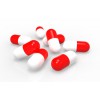Expiration date: 05/2026
International and chemical names: dexamethason?; (9-fluoro-11 ,17,21, trihydroxy-16 -methylpregna-1,4-diene-3,20-dione);
basic physical and chemical properties: tablets of white color;
Composition: 1 tablet contains dexamethasone 0.0005 g (0.5 mg);
excipients: sugar, potato starch, stearic acid.
Form of issue. Pills.
Pharmacotherapeutic group. The glucocorticoids. ATC code B02 H02A.
The pharmacological properties.
Pharmacodynamics. Dexamethasone as a drug from the group of glucocorticoids has anti-inflammatory, anti-allergic effect. Reduces blood levels of eosinophils, lymphocytes, neutrophils. Inhibits the development of connective tissue, reduces the number of fat cells, inhibits hyaluronidase, reduces the permeability of capillaries. Practically does not cause a delay of water and sodium in the body, relatively little effect on the exchange of electrolytes. In effectiveness to 0.5 mg of dexamethasone is equal to about 3.5 mg of prednisone, 15 mg of hydrocortisone, of 17.5 mg of cortisone, a drug that is in 7 times more active than prednisolone and 35 times cortisone.
Pharmacokinetics. Dexamethasone is well absorbed from the gastrointestinal tract, distributed throughout the body. The volume of distribution is similar in patients of all age groups. Dexamethasone is metabolized in the liver. The half-life of dexamethasone is about 3.5 h. the Effect lasts for up to 72 hours Excreted by the kidneys, a very small quantity in the bile as metabolites.
Indications. Treatment of rheumatoid and other arthritis, periarthritis, ankylosing spondylitis, various dermatitis, dermatosis, acute and chronic allergic diseases (asthma, hay fever, hives), Addison's disease, nephrotic syndrome, lymphogranulomatosis, blood diseases (acute lymphoblastic and myeloid leukemia, infectious mononucleosis), for the transplantation of organs and tissues.
Method of application and doses. Dexamethasone administered orally during or after meals. The usual daily dose for adults is 0,002 - 0,003 grams (2 to 3 mg), and in severe cases - up to 0,004 - 0,006 grams (4 - 6 mg). After a therapeutic effect dose gradually move to maintenance dose of 0.0005 - 0,001 g (0,5 - 1 mg) per day. The daily dose is administered in 2 - 3 admission. Children, depending on age, at the discretion and under the supervision of a pediatrician prescribe from 0.00025 grams (0.25 mg, that is ? tablets) to 0,002 grams (2 mg, 4 tablets). Daily doses are in 3 - 4 admission.
Side effects. Steroid diabetes, violation of secretion of sex hormones (menstrual irregularities, hirsutism, impotence), growth retardation in children, secondary adrenal insufficiency, syndrome Cushing's; erosive-ulcerative lesions of the gastrointestinal tract, haemorrhagic pancreatitis, atony of the digestive tract, increased appetite, nausea, vomiting; dizziness, headache, mood lability, depression, psychosis; delay sodium and water, arterial hypertension, increased intracranial and intraocular pressure, increasing the risk of thrombosis; petechiae, striae, skin atrophy, Eskimos; osteoporosis, immunosuppression, increased risk or aggravate fungal, viral or bacterial infections, suppression of regenerative and reparative processes, increased sweating, myopathy, glaucoma, cataracts.
Contraindications. Hypersensitivity to the drug; ulcerative; pronounced osteoporosis, diabetes, hypertension, severe myopathy, acute psychosis, acute renal failure, glaucoma, pre-and post-immunization (especially antiviral), viral disease, systemic mycosis, active tuberculosis, infectious lesions of joints and periarticular soft tissues; pregnancy and lactation.
Overdose. Manifested by increased severity of side effects.
Treatment: cancel the drug; symptomatic therapy. There is no specific antidote.
Features of the application. The treatment of Dexamethasone is given if there are clear indications and under strict medical supervision, taking into account possible contraindications and complications. Treatment should be stopped gradually as sudden cessation of the drug can cause exacerbation of the pathological process. At the end of treatment it is advisable to appoint multiple injections of corticotropin (10 - 20 UNITS a day). You need to constantly monitor blood pressure, glucose content in the blood clotting last, diuresis and body weight.
Diabetes, tuberculosis, bacterial and amoebic infection, hypertension, thromboembolism, cardiac and renal failure to use drug should be very carefully and provided the possibility of simultaneously carrying out an adequate treatment of the underlying disease. If history is an indication of psychosis, therapy is carried out only for health reasons.
In hypothyroidism and cirrhosis of the liver effect of the drug may increase.
During treatment Dexamethasone breast feeding it is advisable to interrupt.
Interaction with other medicinal products. Dexamethasone increases the toxicity of cardiac glycosides (because of the emerging hypokalemia increases risk of arrhythmias), reduces hypoglycemic action of antidiabetic drugs and anticoagulant effect of coumarin derivatives. Rifampicin, phenytoin, barbiturates weaken, and estrogensoderjaschie oral contraceptives increase the effect of dexamethasone. Coadministration of the drug with saluretikami leads to increased excretion of potassium, when administered simultaneously with tireoliberinom reduced the level of triglycerides in the blood. Nonsteroidal anti-inflammatory drugs and ethanol can enhance the security of the development of ulcerations of the mucous membrane of the gastrointestinal tract, in combination with non-steroidal anti-inflammatory drugs to treat arthritis may reduce the dose of corticosteroids due to the summation of therapeutic effect. Antimalarial drugs (chloroquine, hydroxychloroquine, mefloquine), together with dexamethasone can increase the risk of myopathy, cardiomyopathy. ACE inhibitors while the use of dexamethasone can alter the composition of peripheral blood. Immunosuppressive drugs increase the risk of infections and lymphoma or other lymphoproliferative disorders associated with Epstein-Barr. Cyclosporine (inhibits the metabolism) and ketoconazole (decreases clearance) increases the toxicity. High doses of dexamethasone reduces the effect of somatropin. Antacids reduce the absorption of corticosteroids. The drug increases (with prolonged therapy) the content of folic acid. Increases the risk of hepatotoxic reactions of paracetamol (induction of hepatic enzymes and formation of toxic metabolite of paracetamol).
The conditions and duration of storage. Keep out of the reach of children, dry, dark place at a temperature of
15 - 25 °C. shelf Life - 3 years.



